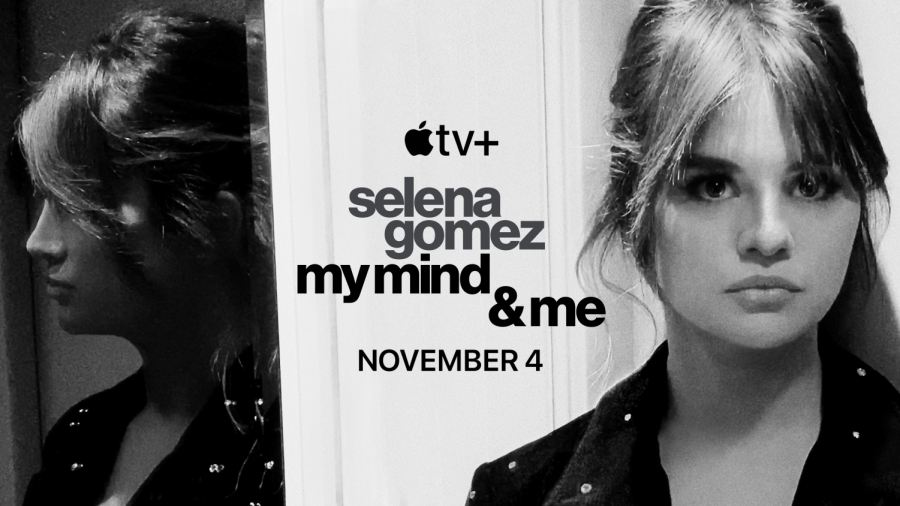My mind & Me: A raw portrayal of fame & mental health
Selena Gomez, dressed in a sparkly outfit and a denim jacket, is sobbing uncontrollably in her dressing room backstage after finishing the final rehearsal for her 2016 Revival tour. “It’s awful,” she says, “I have no idea what I’m doing,” “I don’t want to perform,” she says, breaking down in tears in a heartbreaking scene. The pressure mounts and her mental health begins to deteriorate.
My Mind & Me, Gomez’s new documentary, debuted on Apple TV on November 2 and follows Gomez’s life over a six-year period, ultimately demonstrating Selena’s strength and honesty. The film focuses on Gomez’s insecurities about her body, talent, and effort, as well as her mental health.
Her message: Struggling with emotions does not make us flawed or weak, but simply human.
Gomez is a well-known singer and actress whose work has captivated the world. She is a young woman who appears at ease in public and in front of the camera. However, the revelations in her heartbreaking documentary prove otherwise. In My Mind and Me Gomez opens up about her personal life in the most candid, heartbreaking, and vulnerable way. It focuses on some of her darkest and most troubling secrets through a beautiful lyrical narrative and diaristic technique.
Alek Keshishian, the director, and writer best known for his work on the critically acclaimed documentary Madonna: Truth or Dare, directs the film. The film was originally intended to be a tour documentary, with the typical celebrity glamor shots and behind-the-scenes glimpses, but morphed into a journey of self-love and rediscovery.
Instead of focusing on Gomez’s Disney career, Keshishian chose to focus on her adult career. He highlights on Gomez’s battle with lupus, her kidney transplant, and bipolar disorder and does it in a way that never hides from the audience her less flattering moments nor pushes her too far. It is a challenging balancing act that is pulled off effectively.
In numerous unpolished and private scenes, Gomez visits her Texas hometown to catch up with old friends, and strolls through her neighborhood, exuding warmth and humility. This trip back in time takes advantage of the opportunity to rediscover who she once was.
On a trip to Kenya with the WE organization, Gomez also visits a variety of charities. In these scenes, Gomez quickly bonds with Kenyan children, shares her personal experiences with them and appears happier and more authentic than at any other point in the film.
Later, Gomez appears hesitant to return to her life in the spotlight, as the noise and pressure appear too much for her. With her return comes a slew of new challenges, including trying to meet fan, media, and family expectations. It is impossible not to feel empathy for her as she is treated like a product in a scene where she explains being interviewed and feeling like no one was listening. As the film progresses, she learns how to handle the pressures of stardom, and it is easy to admire how far she has come.
The captivating and moving visuals and transitions presented throughout the movie contribute to the emotional weight the film transmits to its audience. Gomez’s internal battle is revealed in sporadic diary entries and poems. These glimpses of her most private thoughts and feelings give the audience a sense of participating in something very private and deeply personal. The inclusion of Gomez’s personal black-and-white photos resembles Madonna’s Truth-or-Dare and a voiceover reading of her entries accompanies the footage giving the audience insight into the artist’s inner psyche as she navigates through her intrusive thoughts and learns the journey to who she intrinsically is.
Along with her film, Gomez released a song titled My Mind and Me to commemorate the release of her documentary. The song collects many of her emotions into words and the language she is most comfortable with, music. She sings, “My mind and me, We don’t get along sometimes’ in the chorus. Like the documentary, Gomez wished to help others struggling with mental health issues by sharing her own struggles. Her openness lets the audience know that they aren’t alone and that whatever silence battles your fighting, you can get through it. The song was recorded and written in 4 days with the assistance of; Amy Allen, Jon Bellion, Michael Pollack, and the production duo The Monsters & Strangers. Some of which had previously helped Gomez with her previous tracks. In an interview with Vulture Gomez stated.
“I remember releasing all of this stuff to them, and I was scared of what they were going to think. But ‘My Mind and Me,’ the idea and the chorus, came up, and it was really moving to me. These people took my story and made it something bigger than me. I was really grateful.”
We frequently hold celebrities in high regard, celebrate their accomplishments in public, and find it difficult to acknowledge that they have many of the same flaws as the rest of us. Gomez introduces this concept and demonstrates that there is much more to celebrities’ lives than meets the eye in this documentary. Her rise to fame was not without adversity, and Gomez’s willingness to let the audience see everything is truly remarkable and brave in a culture where authenticity is often masked by perfection.




